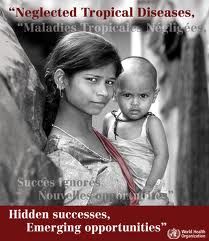 This is a series of diaries focused on the World Health Organization Neglected Tropical Diseases Program. I initially wrote a diary about Dengue Fever that had hospitalized Salon columnist and constitutional lawyer, Glenn Greenwald. The second diary briefly introduced the other diseases on the WHO list.
This is a series of diaries focused on the World Health Organization Neglected Tropical Diseases Program. I initially wrote a diary about Dengue Fever that had hospitalized Salon columnist and constitutional lawyer, Glenn Greenwald. The second diary briefly introduced the other diseases on the WHO list.
This week will focus on Guinea-worm disease (GWD), or Dracunculiasis, which is a debilitating and painful parasitic infection caused by a large nematode (roundworm), Dracunculus medinensis. The guinea worm is one of the best historically documented human parasites, with tales of its behaviour reaching as far back as the 2nd century BC in accounts penned by Greek chroniclers. It is also mentioned in the Egyptian scrolls, dating from 1550 BC. An Old Testament description of “fiery serpents” may have been referring to Guinea Worm: “And the Lord sent fiery serpents among the people, and they bit the people; and much people of Israel died.” (Numbers 21:4-9). The name dracunculiasis is derived from the Latin “affliction with little dragons” while the common name “guinea worm” appeared after Europeans saw the disease on the Guinea coast of West Africa in the 17th century.
It a water born disease and is contracted by drinking stagnant water that has been contaminated with the worm and copepods infested by the larvae. Copepods are tiny crustaceans found in sea and nearly every freshwater habitat. The disease manifests itself about a year after infection, usually as a large blister on the leg, that burns and itches and the mature worm, 1m long, tries to emerge. The infected person tries to relieve the pain by immersing the infected part in water, usually open water sources such as ponds and shallow wells. This stimulates the worm to emerge and release thousands of larvae into the water, thus perpetuating the cycle.
For persons living in remote areas with no access to medical care, healing of the ulcers can take several weeks. People in endemic villages are incapacitated during peak agricultural activities. This can seriously affect their agricultural production and the availability of food in the household, and consequently the nutritional status of their family members, particularly young children. Outbreaks can cause serious disruption to local food supplies and school attendance.
The good news is that the end of GWD is currently in sight. Thanks to President Jimmy Carter and the his Center’s initiative to eradicate this disease there are currently only four countries in the world where GWD is endemic, Sudan, Ghana, Mali and Ethiopia. The major focus is on Sudan where 84% of the 3,190 infections reported in 2009 occurred. WHO predicted it will be “a few years yet” before eradication is achieved, on the basis that it took 6-12 years for the countries that have so far eliminated Guinea worm transmission. Endemic countries must report to the International Commission for the Certification of Dracunculiasis Eradication and document the absence of indigenous cases of GWD for at least three consecutive years to be certified as Guinea worm-free. Guinea worm disease will be only the second human disease, after smallpox, to be eradicated globally.
Prevention
Guinea worm disease can only be transmitted by drinking contaminated water, and can be completely prevented through relatively simple measures that could result in the disease being eradicated:
* Drinking solely water drawn from underground sources free from contamination, such as a borehole or hand-dug wells.
* Filtering drinking water, using a fine-mesh cloth filter like nylon, to remove the guinea worm-containing crustaceans.
* Preventing people with emerging guinea worms from entering ponds and wells used for drinking water.
* Developing new sources of drinking water that lack the parasites, or repairing dysfunctional ones.
Water sources can also be treated with larvicides to kill worm-carrying crustaceans.
Further discussion is below the fold, since the brief description of treatment and video are graphic and not for the squeamish.

 This is a series of diaries focused on the
This is a series of diaries focused on the
Recent Comments